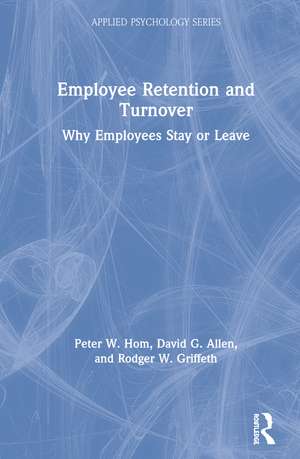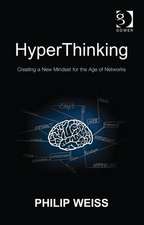Employee Retention and Turnover: Why Employees Stay or Leave: Applied Psychology Series
Autor Peter W. Hom, David G. Allen, Rodger W. Griffethen Limba Engleză Paperback – 6 sep 2019
Employee Retention and Turnover contextualises the issue of turnover, its causes and its consequences, before discussing underrepresented antecedents of turnover, key aspects of retention and methods for regulating turnover, and future research directions.
Ideal for both academics and advanced students of industrial/organizational psychology, Employee Retention and Turnover is essential for understanding the past, present, and future of turnover and related research.
Din seria Applied Psychology Series
-
 Preț: 151.65 lei
Preț: 151.65 lei -
 Preț: 288.37 lei
Preț: 288.37 lei - 8%
 Preț: 543.04 lei
Preț: 543.04 lei - 9%
 Preț: 1073.61 lei
Preț: 1073.61 lei -
 Preț: 356.63 lei
Preț: 356.63 lei - 25%
 Preț: 1057.78 lei
Preț: 1057.78 lei - 16%
 Preț: 156.59 lei
Preț: 156.59 lei -
 Preț: 486.38 lei
Preț: 486.38 lei -
 Preț: 449.41 lei
Preț: 449.41 lei -
 Preț: 524.97 lei
Preț: 524.97 lei -
 Preț: 495.03 lei
Preț: 495.03 lei -
 Preț: 462.60 lei
Preț: 462.60 lei -
 Preț: 496.01 lei
Preț: 496.01 lei - 15%
 Preț: 545.79 lei
Preț: 545.79 lei -
 Preț: 449.41 lei
Preț: 449.41 lei -
 Preț: 392.93 lei
Preț: 392.93 lei - 18%
 Preț: 1001.84 lei
Preț: 1001.84 lei -
 Preț: 494.66 lei
Preț: 494.66 lei - 25%
 Preț: 823.99 lei
Preț: 823.99 lei -
 Preț: 454.81 lei
Preț: 454.81 lei - 15%
 Preț: 465.94 lei
Preț: 465.94 lei -
 Preț: 469.34 lei
Preț: 469.34 lei - 16%
 Preț: 249.24 lei
Preț: 249.24 lei - 18%
 Preț: 1120.23 lei
Preț: 1120.23 lei -
 Preț: 506.11 lei
Preț: 506.11 lei - 18%
 Preț: 1113.91 lei
Preț: 1113.91 lei -
 Preț: 143.43 lei
Preț: 143.43 lei - 15%
 Preț: 430.45 lei
Preț: 430.45 lei - 18%
 Preț: 1005.80 lei
Preț: 1005.80 lei -
 Preț: 492.96 lei
Preț: 492.96 lei -
 Preț: 449.41 lei
Preț: 449.41 lei - 18%
 Preț: 952.46 lei
Preț: 952.46 lei -
 Preț: 203.79 lei
Preț: 203.79 lei -
 Preț: 489.26 lei
Preț: 489.26 lei -
 Preț: 450.58 lei
Preț: 450.58 lei - 12%
 Preț: 318.90 lei
Preț: 318.90 lei - 12%
 Preț: 299.52 lei
Preț: 299.52 lei - 25%
 Preț: 1229.97 lei
Preț: 1229.97 lei - 26%
 Preț: 822.34 lei
Preț: 822.34 lei -
 Preț: 443.65 lei
Preț: 443.65 lei - 15%
 Preț: 461.03 lei
Preț: 461.03 lei
Preț: 416.44 lei
Nou
Puncte Express: 625
Preț estimativ în valută:
79.71€ • 82.90$ • 66.79£
79.71€ • 82.90$ • 66.79£
Carte tipărită la comandă
Livrare economică 13-27 martie
Preluare comenzi: 021 569.72.76
Specificații
ISBN-13: 9781138503816
ISBN-10: 1138503819
Pagini: 352
Ilustrații: 34 Line drawings, black and white; 13 Tables, black and white
Dimensiuni: 152 x 229 x 23 mm
Greutate: 0.46 kg
Ediția:1
Editura: Taylor & Francis
Colecția Routledge
Seria Applied Psychology Series
Locul publicării:Oxford, United Kingdom
ISBN-10: 1138503819
Pagini: 352
Ilustrații: 34 Line drawings, black and white; 13 Tables, black and white
Dimensiuni: 152 x 229 x 23 mm
Greutate: 0.46 kg
Ediția:1
Editura: Taylor & Francis
Colecția Routledge
Seria Applied Psychology Series
Locul publicării:Oxford, United Kingdom
Public țintă
Postgraduate and ProfessionalCuprins
Table of Contents
List of Illustrations
Biographies
Series Foreword
Preface
Chapter 1: What Is Turnover, Why Is It Important, and How Is It Measured?
List of Illustrations
Biographies
Series Foreword
Preface
Chapter 1: What Is Turnover, Why Is It Important, and How Is It Measured?
- Turnover Significance
- Voluntary vs. Involuntary Turnover;
- Avoidable vs. Unavoidable Turnover
- Functional vs. Dysfunctional Turnover
- Withdrawal Behavioral Family
- Turnover Destinations
- Collective Turnover
- Turnover Effects on Leavers
- Turnover Effects on Stayers
- Turnover Effects on Organizations
- Collective Turnover
- Determining Optimal Turnover Rates
- Summarize Empirical Findings on Predictors of Individual Turnover from Past and Current Broad-Based Meta-Analyses
- Describe and Review Classic Models
- Describe and Review Contemporary Theories, notably, the Unfolding Model
- Review Original 2001 Model of Job Embeddedness and Its Refinement
- Extension of Basic Model to Explain Other Forms of Work Embeddedness
- Multifocal Model of Job Embeddedness
- Proximal Withdrawal State Theory
- Dark Side of Job Embeddedness
- Organizational Commitment – Commitment Profiles
- Job-Satisfaction – Trajectories Over Time
- Job Performance – Complex Dynamics
- Movement Ease and the Employment Opportunity Index
- Intervening Role of Job Search in Turnover Process
- Cybernetic Theory about Job search and Turnover
- Leadership Influences on Subordinate Turnover
- Leadership Style and Personality
- Managerial Attempts to Predict and Prevent Turnover
- Leader Departure Effects
- Social Networks – Structural Features
- Snow Ball Effect
- Network Centrality
- Network Closure
- Personality Influences
- Personality Traits
- Cognitive-Affective Processing System Theory
- Standard Research Practice: Critique of Static Cohort Research Design
- New Statistical Methods for Predicting Turnover
- Modern-Day Statistical Methods for Testing Turnover Theories
- Realistic Job Previews (RJP)
- Recruitment Source – Employee Referrals
- Hiring Based on Biodata
- Hiring Based on Personality
- Hiring for Fit
- Socializing Newcomers
- Work Design
- Compensation & Reward Practices
- Promising New Approaches
- Pre-Quitting Behaviors
- Stay Interviews
- Predictive Analytics
- Women Corporate Flight
- Sexual Harassment
- Racial Minority Turnover
- Intersectional Discrimination
- Double Jeopardy
- Subordinate Male Target Hypothesis
- International Diversity and Turnover
- Expatriate Withdrawal
- Turnover among Assembly Workers in Export-Oriented Processing Zones in Emerging Economies
- Investigating Change Trajectories of Turnover Predictors
- Person-Centered Analyses
- Construct Validation
- More Research on Shocks, Link Defections and Turnover Destinations
- Generalization vs. Contextualization of Theories
- Understanding Collective Turnover
- Empirical Validation of Methods for Controlling or Predicting Turnover
Notă biografică
Peter W. Hom is a Management Professor at the WP Carey School of Business, Arizona State University, USA. He has investigated why people quit, how managers react when their subordinates are being poached, and why employees trapped in jobs misbehave.
David G. Allen is Professor in the Neeley School of Business at Texas Christian University, USA. His teaching, research, and consulting on people and work focus on the flow of human capital into and out of organizations.
Rodger W. Griffeth is a Professor Emeritus in the Psychology Department at Ohio University. He has authored many seminal top-tier journal articles on employee turnover, while authoring three books on this topic.
David G. Allen is Professor in the Neeley School of Business at Texas Christian University, USA. His teaching, research, and consulting on people and work focus on the flow of human capital into and out of organizations.
Rodger W. Griffeth is a Professor Emeritus in the Psychology Department at Ohio University. He has authored many seminal top-tier journal articles on employee turnover, while authoring three books on this topic.
Recenzii
"This book is outstanding in so many ways. First it lays out developmentally how the complexity of this topic has evolved over time. This picture includes how theory has changed, how our results and understanding have expanded over time and how extensions now deal with a much broader phenomenon including the international implications of the findings. Second, it is simply the best scholarly treatment of the turnover topic. The authors are exceptionally well versed in the literature and constructs being tested as well as the complex methods being used to study this phenomenon over time, contexts and samples and the practical implications of these findings. It will serve as the "go to" book for years to come." - Terence Mitchell, University of Washington
"This timely book by a team of preeminent scholars in the area of employee turnover will be of benefit to both researchers and managers. Decades of research have demonstrated the high cost of turnover to organizations. Grounded in the accumulated wisdom of thousands of empirical studies, coupled with the latest in practice, this book will guide efforts to develop state-of-the-art retention policies. It also will guide future research on the topic in an era of increasingly smart machines and dynamic labor markets." - Brooks Holtom, Senior Associate Dean, McDonough School of Business, Georgetown University
"This timely book by a team of preeminent scholars in the area of employee turnover will be of benefit to both researchers and managers. Decades of research have demonstrated the high cost of turnover to organizations. Grounded in the accumulated wisdom of thousands of empirical studies, coupled with the latest in practice, this book will guide efforts to develop state-of-the-art retention policies. It also will guide future research on the topic in an era of increasingly smart machines and dynamic labor markets." - Brooks Holtom, Senior Associate Dean, McDonough School of Business, Georgetown University
Descriere
This exploration of what employee turnover is, why it happens and what it means for companies and employees draws together contemporary and classic theories and research to present a well-rounded perspective on employee retention and turnover.







